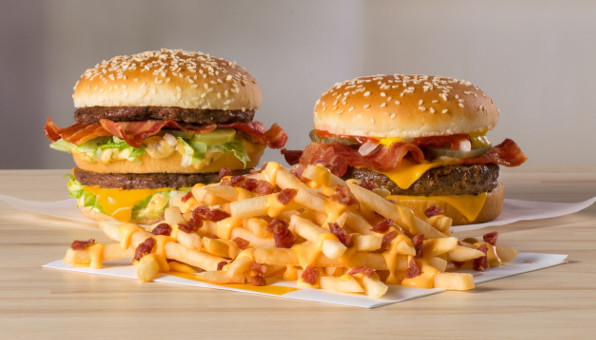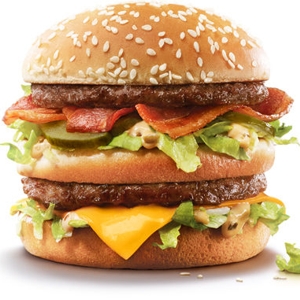A new multi-country study says that large restaurant meals contribute materially to the development of obesity. Dr. Obvious says science once again confirms what we already knew. I wonder why such research projects get funded in the first place…
 Today’s Big Burgers clock in at over 500 Calories apiece. Add fries
Today’s Big Burgers clock in at over 500 Calories apiece. Add fries
and you can double that, which is half of your daily
Calorie intake allotment in one meal…
What they did…
Researchers measured the energy content (Calories) of a representative sample of 223 popular meals purchased from 111 randomly selected sit-down restaurants and fast food outlets in in Brazil, China, Finland, Ghana and India.
What they found…
Results showed that 94 percent of the most popular main dishes served in sit-down restaurants and 72 percent of those purchased over the counter from fast food outlets contained more than 600 kilocalories (kcal), the benchmark recently recommended by the United Kingdom’s National Health Service (NHS) to help reduce the global obesity epidemic. NHS guidelines are in close agreement with U.S., Canadian and European dining recommendations. Previous studies revealed that North American restaurant portions are generally larger than recommended in government and medical sector guidelines. Both sit-down restaurant meals and Fast Food take-out foods may be higher in Fats and added Sugar, the Study explains.
The takeaway…
“Obesity is a world health problem caused by several factors, such as sedentary living, processed food and sugar intake, and overeating. Many people [may] confuse food craving with hunger. This study shows that any strategy to combat obesity should also consider these excesses,” said article Contributor Vivian Suen, a Professor in the Department of Clinical Medicine at the University of São Paulo’s Ribeirão Preto Medical School (FMRP-USP).
“When non-obese people have a large midday meal, they normally feel less hungry in the evening and eat less for dinner, for example,” she said. “However, obese people appear not to have this perception, as has been found in several studies by the research group at Tufts University. Therefore, this regulation in terms of eating less in the next meal doesn’t happen in obese individuals.”
My take..
The needle on my ‘D’oh!’ Meter just went off the scale.
Dr. Obvious gave me no credit – much less a prize – for realizing, on my own, that bigger meals contain more Calories, and more Calories means a greater risk of developing obesity. How many times have we heard that warning before? More than I can count. It all comes down to which foods we should seek out vs. which that are going to be bad for us. But researchers from prestigious universities won’t simply say that. They have to justify their salaries, tenure and grants.
What about making resto portions smaller?
It would be very easy to implement, but resto operators wouldn’t go for it unless forced to by new laws or regulations. They know diners judge value in their restaurant and Fast Food meals by quantity. The more they get for their money, the better the value. Really?
To fill the basket or or top up the take-out box, restaurant operators have long resorted to stuffing them with fries. You look at it and think you’re getting a good deal, but the Fries cost only $0.05 to $0.10 per serving to make whey they’re produced in bulk at restos, so the cost increase to serve a bigger ‘order’ is insignificant. Alas, Fries have been repeatedly identified as major contributors to the Obesity Epidemic, since they contain so much Fat and empty Calories. And padding orders with extra fries is inherently wasteful. Even if they love fries, the average person won’t eat all the Fries in the box or basket. But they’ll fill themselves up to the brim before they can cram them all down, contributing to the global food waste crisis and eating too much in the process.
*SIGH*
~ Maggie J.

